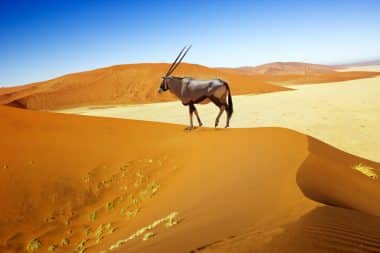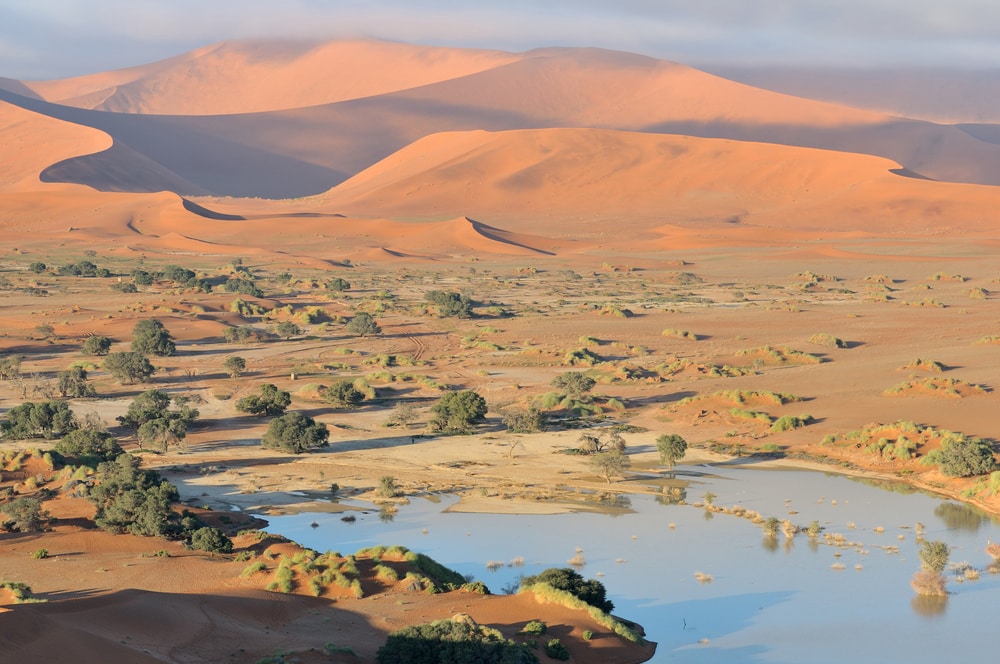If you are traveling in the interior of Namibia, you should definitely make a detour to the Namib-Naukluft National Park, the largest protected area in the country. In the middle of this breathtaking protected area, about 50 kilometers from the Atlantic coast, is the Sossusvlei. The huge dune landscape in the middle of the Namib coastal desert, which is considered one of the largest dune landscapes in the world, is one of the absolute highlights of a trip to Namibia.
The Sossusvlei is a so-called salt-clay pan, which is completely enclosed by sand dunes up to 300 meters high. This breathtaking natural attraction was created over the past millennia by the silting up of the Tsauchab River. As part of the vast Namib Sand Sea, Sossusvlei has been a UNESCO World Heritage Site for several years. Only very rarely, after heavy rainfall, does the washed out depression of the Sossusvlei fill with water. This spectacle takes place about every ten years. Since this rainwater cannot drain off due to the impermeable layer of clay that has formed over the millennia, a large blue lake is formed. This is then even retained for some time and offers a further colour contrast to the different layers of sand.
Fascinating atmosphere at sunrise

Every year, many thousands of tourists visit the region to enjoy the fascinating play of colours of the many different layers of sand – from deep red to bright yellow – and the breathtaking atmosphere in the middle of the Namib Desert and to capture them on camera. We recommend an extensive visit in the early morning hours to experience the sunrise, which significantly enhances this atmosphere and the play of colours. It is not for nothing that Sossusvlei is one of the most popular photo motifs in the world.
In addition to the huge sand dunes, you can also discover numerous small and large desert animals and plants throughout the region. Among other things, with a bit of luck, you can also come across pinboks, pussotters or sand lizards on an adventurous desert safari. The Sossusvlei is easily accessible from the entrance of the Namib-Naukluft National Park in the small village of Sesriem via a well-developed main road. However, the last few kilometres through the sand have to be covered on foot or in a four-wheel drive vehicle. Throughout the national park there are numerous accommodations at some smaller campsites.
A wide variety of tour operators also offer the opportunity to explore the huge dune landscape from a plane or even a hot air balloon. The latter in particular offers a spectacular view of the entire landscape, especially at sunrise, which will definitely remain unforgettable forever. To explore the region and let the countless impressions work their magic on you, you should definitely take a lot of time. And if you don’t want to explore the dune landscapes on your own, you also have the option of taking part in one of the numerous guided hikes. Here you can also learn many exciting things about the development of Sossusvlei in the past centuries.
Best time to visit from August to October
The best time to travel to Namibia and visit Sossusvlei is considered to be the summer and autumn months from August to October. During this time, there are extremely pleasant and warm temperatures of about 25 degrees Celsius and bright sunshine during the day. In the European winter months – the African summer – the temperatures are almost unbearable at 40 to 50 degrees Celsius.


